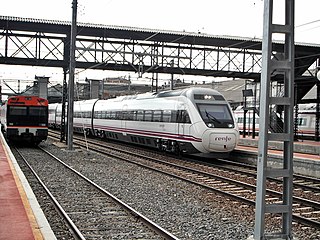
A tilting train is a train that has a mechanism enabling increased speed on regular rail tracks. As a train rounds a curve at speed, objects inside the train experience centrifugal force. This can cause packages to slide about or seated passengers to feel squashed by the outboard armrest, and standing passengers to lose their balance, or in such excessive speeds, could even cause the train to derail. Tilting trains are designed to counteract this by tilting the carriages towards the inside of the curve, thus compensating for the g-force. The train may be constructed such that inertial forces cause the tilting, or it may have a computer-controlled powered mechanism.

Renfe, officially Renfe-Operadora, is Spain's national state-owned railway company.

Talgo is a Spanish manufacturer of intercity, standard, and high-speed passenger trains. Talgo is an abbreviation of Tren Articulado Ligero Goicoechea Oriol

InterCity is the classification applied to certain long-distance passenger train services in Europe. Such trains generally call at major stations only.

Cercanías Madrid is the commuter rail service that serves Madrid, the capital of Spain, and its metropolitan area. It is operated by Cercanías Renfe, the commuter rail division of Renfe, the former monopoly of rail services in Spain. Its total length is 370 km.

The British Rail Class 210 was a type of diesel-electric multiple unit (DEMU) passenger train designed and constructed by British Rail Engineering Limited's Derby Litchurch Lane Works.

The Class 82 was a type of sub-urban rail electric multiple unit that once operated by Keretapi Tanah Melayu on its KTM Komuter services. Each unit consists of two driving motor cars and a trailer cars. All were retired by 2012 after being replaced by the Class 92.

Stadler FLIRT is a passenger multiple unit trainset made by Stadler Rail of Switzerland. The baseline design of FLIRT is an electric multiple unit articulated trainset that can come in units of two to twelve cars with two to six motorized axles. The maximum speed is 200 km/h (125 mph). Standard floor height is 57 cm, but 78 cm high floors are also available for platform heights of 76 cm.

The Renfe Class 100 is a high-speed train used for AVE services by the Renfe Operadora, in Spain. It was the first high-speed train put into service in Spain, in 1992.

The Renfe Class 102 or S-102 is a high-speed train used for the AVE service and operated in Spain by the state-run railway company Renfe, and based on Bombardier Transportation's power car technology. Outside AVE service, Talgo markets this train as the Talgo 350.

The Renfe Class 103 is a high-speed train used for the AVE service and operated in Spain by the state-run railway company RENFE. The trainset is also known as S103 or S/103.

The Renfe Series 333 are high power six-axle diesel-electric locomotives built in the 1970s; at the time of their introduction they were the most powerful non-electric locomotives in Spain.

The Renfe Class 352 was a class of twin engined four axle diesel-hydraulic locomotives built by Krauss-Maffei, designed solely for passenger traffic; in particular they were responsible for towing Andalusian Talgo III trains. The class were very successful, heralding a new era of passenger trains in Spain. They were delivered in 1964 and 1965, and were fully withdrawn during the 1990s.

The Renfe Class 354 was a series of eight diesel hydraulic locomotives manufactured by Krauss-Maffei in Germany specifically to pull Talgo pendular coaches which were introduced shortly before the acquisition of these machines.

The Renfe Class 130 or S-130 is a high-speed dual-gauge, dual-voltage trainset consisting of 11 Talgo VII tilting coaches and two power cars, used on Alvia and Euromed services. The class have been nicknamed patitos (ducklings), due to the shape of the train nose.

The Renfe Class 120 are electric multiple units used on Alvia high-speed rail services in Spain.

Civia is a class of electric multiple unit trains built by CAF, Siemens and Alstom for the Renfe Cercanías commuter railway networks in Spain. The first units entered service in 2003.

The CAF Civity is a platform of regional passenger trains which is manufactured by Spanish rolling stock manufacturer Construcciones y Auxiliar de Ferrocarriles. Available as both diesel, electric and battery-electric multiple unit, the Civity was first launched in 2010 and received its first order two years later.

The Renfe Class 447 is a class of electric multiple unit trains built by CAF, Alstom, Siemens, ABB, and Adtranz for Renfe Cercanías, Spain's commuter railway networks. The first units entered service in 1993.

Line C-9, formerly known as the Guadarrama Electric Railway, is a narrow-gauge mountain railway incorporated into Madrid's Cercanías commuter rail network. The line is operated by Renfe Operadora and runs through the Guadarrama Mountains from Cercedilla, Madrid to Cotos Pass, Segovia. Although classified as a commuter rail line, Line C-9 primarily serves the ski resorts at Cotos and Navacerrada Passes, connecting with the rest of the commuter rail system with the Line C-8 at Cercedilla Station. Line C-9 is the only metre-gauge railway among the Cercanías Madrid lines.




















